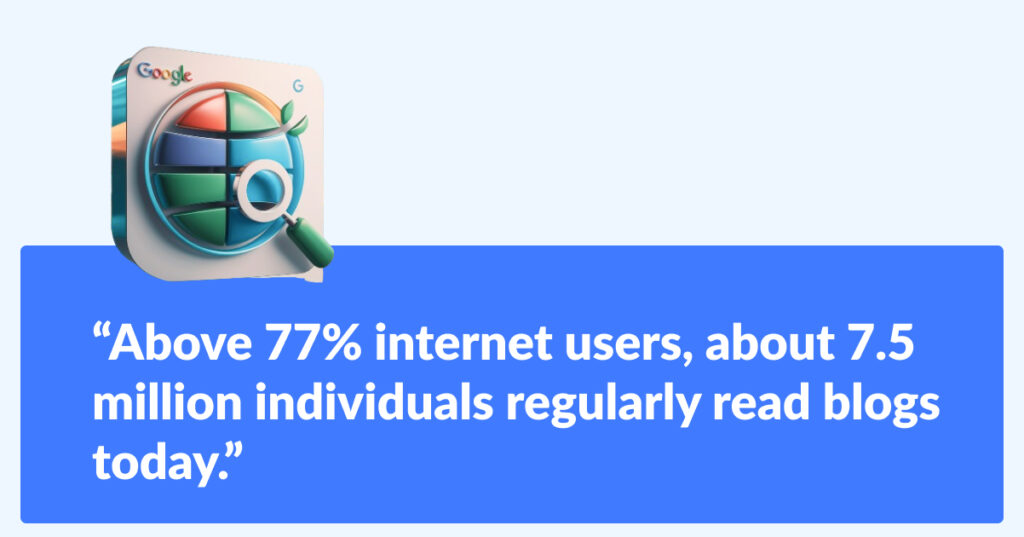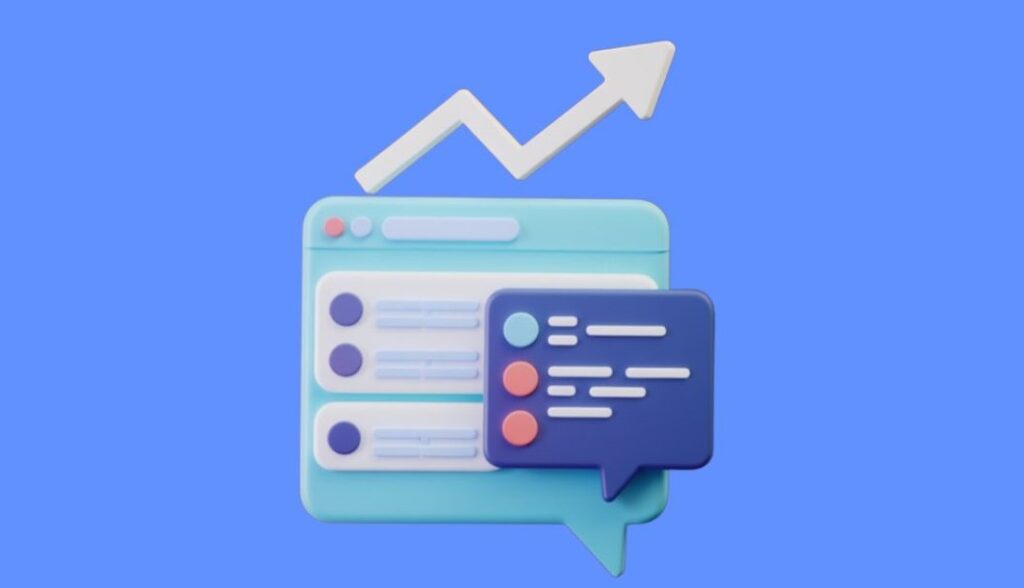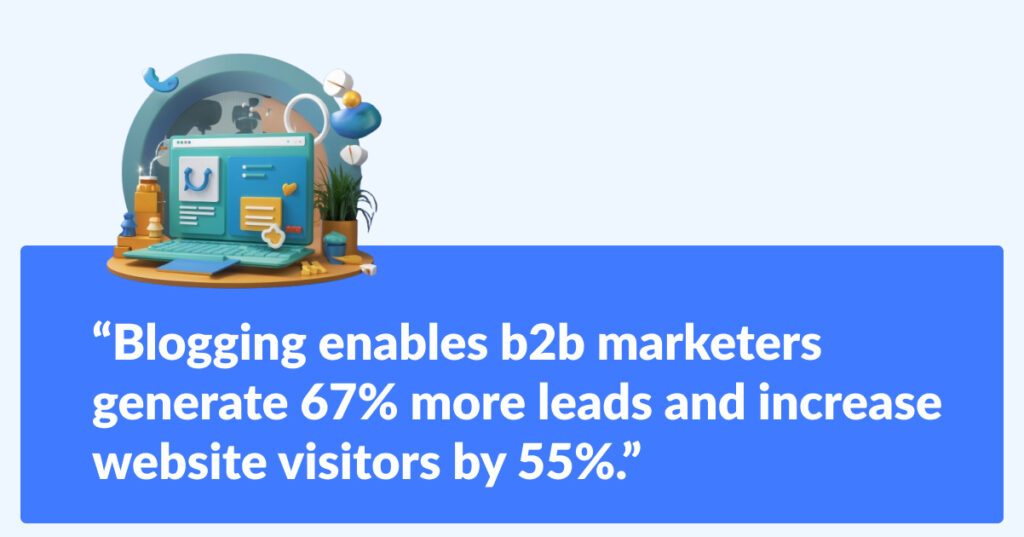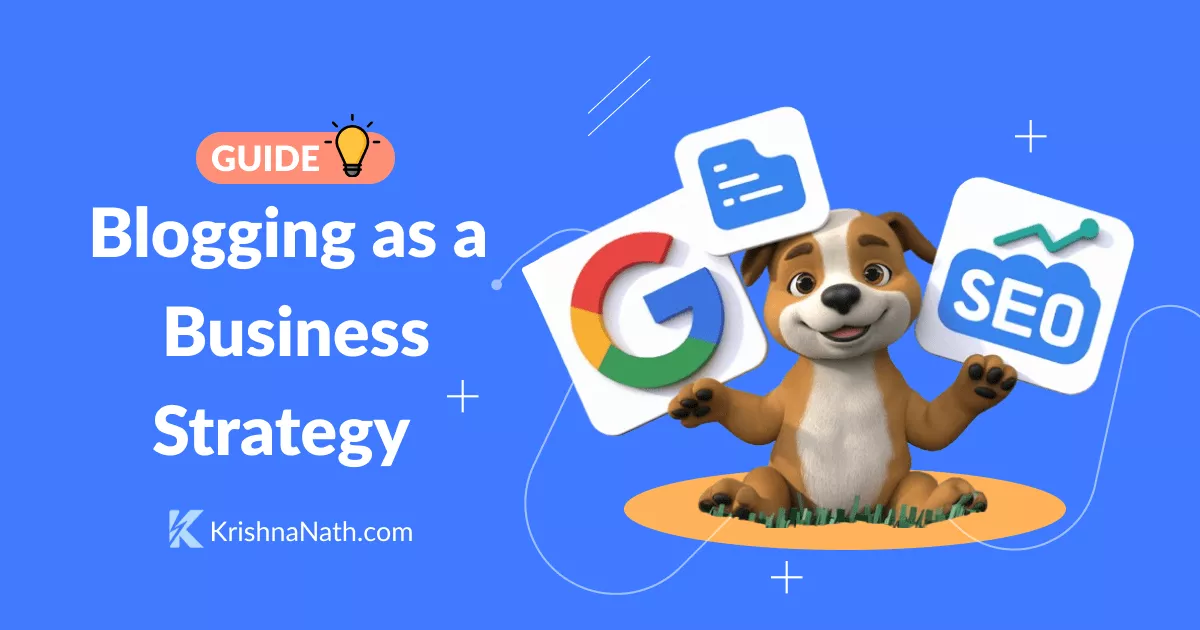Online searches are the cornerstone of decision-making in 2024, with Google processing 22.08 billion queries daily—equivalent to 255,600 searches every second.
These growing demands emphasize the importance of high-quality content and introduce blogging, a practice involving creating and publishing valuable articles on digital platforms.
Once personal diaries, blogs have become vital learning tools, helping businesses educate their readers, even in the AI era. Therefore, this blog will dive into how blogging helps businesses build authority and drive growth.
This Blog Explores
1. Introduction to Blogging

Blogging is the activity of creating, sharing, and regularly updating content on various digital platforms. These platforms can range from personal or business websites to social media channels such as YouTube and Instagram.
A blog offers in-depth, updated guides and equips the readers with current insights, informing users about the current market trends and upcoming changes.
Blog managers referred to as bloggers, handle several responsibilities- from crafting engaging content to optimizing the pages for search engines to promoting on social media.
2020’s marketing landscape has become increasingly focused on organic traffic compared to paid traffic, transforming blogging as a cost-effective method for building brand credibility and boosting sales.
Globally, 71% of businesses keep a website and over 65% incorporate a blog section on their website to communicate with the audience. Above 77% of internet users, about 7.5 million individuals regularly read blogs today.

Blogging is widely regarded as a cornerstone in the digital content creation domain. It continues to secure the leading position among all the content genres owing to its ability to educate readers and drive organic traffic from search engines.
Why Does Blogging Matter?
Businesses maximize the presence of a blog by consistently informing readers and potential customers with updates on industry trends, best practices, and recommendations.
These efforts empower marketers to strengthen sales funnel stages, generate leads and customers, and foster brand recognition.
Blogging is pivotal for several reasons:
- SEO benefits: Improve search engine visibility and rankings
- Increased traffic: Attracts more visitors to your website.
- Authority building: Puts your brand as an industry leader.
- Engagement and leads: Converts readers into loyal customers.
In fact, Absurdinsights reports companies that blog generate 67% more leads compared to non-blogging business owners with 13x greater return on investment.
2. Evolution Of Blogging From Personal Journaling To Business Growth

Blogging has embraced numerous transformations since its launch, similar to platforms like YouTube and Facebook. It has evolved from personal diaries to professional platforms, integrating SEO, multimedia, and mobile optimization. Here’s how blogging has evolved:
A. Personal Journals (Late 1990s – Early 2000s)
Individuals and professionals initially utilized blogging as a public diary to share their personal stories, experiences, and hobbies with a narrow audience.
In the late 1990s and early 2000s, personal journals flourished on platforms, such as Blogger, Live Journal, Myspace, Xang, and more.
Such online platforms enabled users to share their content and increase their friend lists. These personal documents initiated the future growth of blogging.
b. Niche Content and Communities (Mid-2000s)
In the mid-2000s, personal journals advanced into niche content, as blogging expanded to a wider audience. Bloggers began emphasizing specific topics and delved into niche markets, such as fashion, food, tech, and travel, attracting like-minded users.
This phase also witnessed the rise of influential individual bloggers, referred to as the first generation of “influencers”, and the origin of the influential marketing domain.
c. SEO and Monetization (Late 2000s)
By the late 2000s, bloggers and businesses understood the potential of blogging for Search Engine Optimization (SEO) and content marketing. Blogs helped enterprises entice organic traffic from search engines, establish credibility, and boost sales.
Therefore, individual bloggers and businesses switched their focus to creating SEO-friendly, helpful user-centric content over keyword-stuffing and black hat strategies.
Moreover, the introduction of SEO tools enabled website administrators to efficiently analyze website performance and track user behavior.
Such tools were Google Analytics, Google AdWords Keyword Tool, Wordtracker, Overture Keyword Selector Tool, and more.
Reaching a growing audience allowed individual bloggers and businesses to monetize their blogs through ads, affiliate marketing, and sponsored posts.
And, a noticeable element in the late 2000s was the increased emphasis on technical SEO and quick monetization techniques.
D. Content Marketing and Business Blogging (2010s)
In the 2010s, blogging transformed into a more strategic content marketing approach and helped marketers engage audiences, introducing inbound marketing in action.
Sales Funnel strategies became an essential part of content marketing in this phase. A Sales funnel incorporates several stages, including awareness (top), consideration (middle), and decision (bottom), implemented to draw in prospects and drive sales.
These stages encompass different content objectives: awareness stages educate potential customers about their problems and introduce solutions through blog posts and infographics.
The consideration stage comes with detailed guides, like case studies, and product overviews, nurture leads and provide valuable information. Conversion stages focus on persuasive content and influence buying decisions.
Altogether, the 2010s accentuate a transitional period, from keyword-stuffed content to people-first content.
E. Advanced Strategies and Blogging for Growth (2020s)
The 2020s have adopted several transformations in blogging and SEO with more user-centric and result-driven content marketing approaches.
One of the major adoptions is implementing AI-powered tools in content creation, such as ChatGPT, Perplexity AI, Claud AI, Jasper AI, and other tools.
These AI tools empower marketers with quick responses, providing accurate information based on the queries and enhancing the efficiency of content creation.
Influencer Marketing reports that 40% of businesses reduced content creation time to under five hours weekly. Additionally, 62% of marketers believe AI to positively impact content quality over time.
Along with the positives, AI tools bring low-quality, keyword-stuffed spammy content that often violates search engines like Google’s spam policies. Such content generally fails to satisfy user expectations due to a lack of depth, information, and engagement.
To tackle low-value content, Google introduced EEAT guidelines– which stand for Expertise, Experience, Authoritativeness, and Trustworthiness.
However, Google encouraged using AI in content creation and clearly stated on Google Search Central Blog that AI possesses the ability to help marketers create valuable content in research, data analysis, and gathering materials.
Writers can not just copy-paste the same information that is already available on Google.
Overall, blogging has become a more useful resource for individuals, assisted by AI technology and adherence to search engine guidelines. It is both helping people and scaling business growth.
3. How Blogging Can Solidify Your Brand?

Blogging invariably remains relevant in today’s age of AI. It establishes your brand, brings organic traffic to your company site, and generates substantial revenue.
A. Visibility and Organic Traffic:
Blogs improve online visibility and drive organic traffic from search engines by implementing SEO strategies and creating EEAT-friendly content.
Research says, blogs can drive 55% more website visitors compared to static sites and SEO can boost inbound links by 97%, and attract 55% more visitors. This emphasizes their effectiveness as a marketing strategy.
B. Brand Credibility and Trust:
Businesses can showcase their expertise and knowledge by consistently providing valuable content and addressing potential customers’ issues.
This helps win potential customers and generate more leads. According to Optinmonster reports, 71% of B2B buyers read blogs before making a purchase, and companies that blog generate 67% more leads.
C. Engagement and Community Building:
WordPress shares ‘live look’ stats showing that 409 million people view over 20 billion blog pages every month.
This data underlines the significance of sharing helpful content that cultivates customer engagement and allows brands to connect personally with their audience.
D. Cost-effective Marketing:
Blogging is a low-cost marketing approach as compared to other methods, such as paid ads and influencer marketing.
Starting a blog requires only a domain name, an affordable hosting platform, and a free CMS platform like WordPress.
Additionally, the ROI of blogging is substantial and it can minimize Customer Acquisition Costs (CAC) by enhancing lead generation and improving customer engagement.
Overall, blogging is an effective and cost-efficient marketing approach that continues to yield long-term benefits for businesses.
4. Key Strategies for Effective Business Blogging

Business blogging thrives on clear goals, targeted audiences, and high-value content. By connecting SEO practices with engaging visuals, businesses can boost visibility, credibility, and lead generation.
A. Identifying Audience Needs
Identifying and understanding your audience is pivotal for blogging and all online business success.
Furthermore, tailored marketing strategies, based on customer needs and preferences, can meet customer satisfaction. Additionally, it increases customer satisfaction and loyalty.
A deep analysis of customer feedback, reviewing queries of users on social media sites, and forums, and observing search trends can insight into prospects’ needs.
This approach involves conducting deep research on behaviors, interests, and pain points of your target audience throughout a buyer’s journey, including awareness, consideration, and decision stages.
According to Epsilon, tailored marketing efforts can drive higher returns on investment, as 80% of consumers prefer brands offering tailored interactions.
B. Creating Tailored Content
Audience-focused content, addressing prospect’s issues at various stages of a buyer’s journey, provides value-driven solutions to specific pain points.
Various stages in a sales funnel incorporate different content formats, such as Top of The Funnel (TOFU), Middle of The Funnel (MOFU), and Bottom of Funnel (BOFU) content. These stages have different objects.
The TOFU content aims to raise awareness and entice a broad audience, the MOFU content focuses on educating prospects, and the BOFU content directly influences them to purchase.
These stages encompass specific content formats:
- TOFU: Blog posts, Infographics, E-books, Podcasts, Webinars.
- MOFU: In-depth blog posts, Whitepapers, Case studies, Videos, and Tutorials.
- BOFU: Product demos, Pricing pages, Comparison charts, Testimonials, Free trials.

In fact, based on reports, 45% of consumers say they would be more likely to purchase from a brand that offers personalized content, particularly at the BOFU stage.
C. SEO Best Practices for Blogging Success:
Blogging holds the supreme position in the digital market due to its SEO benefits. Compared to paid campaigns, SEO offers long-term, steady organic growth over time, reducing the expenditure.
There are various On-page and Off-page SEO practices to optimize for maximum SEO success. Below are nine major practices.
- Keyword Research:
Identifying a target audience and conducting thorough keyword research enables you to discover what potential customers are searching on the internet.
In particular, incorporating long-tail keywords and search queries with informational intent into the strategy drives substantial results.
- On-page Optimization:
Structuring your content, and following On-page SEO guidelines, allows users and search engines to know about your content.
On-page SEO optimization takes in optimizing headings, main content, meta description, image optimization, URL structure, image optimization, and other vital elements of website pages.
- EEAT Principles:
As per EEAT guidelines, providing information-rich, in-depth content is mandatory to rank higher on Google.
Additionally, you must add author information, covering your work experience, and qualifications.
- Internal and External Linking:
Link to other relevant blog posts or pages published under your website and informative sources by other authoritative external sources.
- Mobile Friendliness and Page Speed:
Optimize your blog and entire website for mobile users, as 50% of online traffic comes from mobile devices.
Additionally, ensure your web page loads in two seconds or less. Research says 40% of users abandon websites taking above 3 seconds for loading. Given the comparative nature of SEO, fast loading time is crucial.
- Update Old Content:
Update old content with new information, trending keywords, current trends, and statistics to keep your content relevant and fresh.
Ensure refreshing old data with new statistics and current info from genuine sources. Also, include updated old visuals, infographics, and charts for better engagement.
5. The Importance of Consistent Blogging

Consistent blogging brings various benefits to the company. It increases companies’ brand presence, builds authority, increases engagement and organic growth, and has many vital long-term benefits.
A. Build Credibility
When companies publish quality blogs regularly, readers get insights about various topics within a specific domain. Moreover, sharing valuable assets for the long term fulfills the expectation of new content with resources.
This educates your audience and encourages them to return consistently to the website, establishing a loyal audience base.
B. Improve SEO Performance
Search engines like Google prioritize some specific algorithm techniques. One of them is consistent blogging.
Websites with regular blogs and content updates are more likely to get crawled and indexed by Google.
C. Establish Authority In A Niche
Regular blog updates with in-depth information and up-to-date metrics serve as credible sources of information for the audience.
This communicates to search engines and readers that the content is fresh and relevant, improving SEO performance.
Also, the practice of frequently engaging with the audience through comments and on various social media platforms builds a strong community around the blog.
D. Cultivate Brand
Regular posts with quality information showcase expertise in a specific niche. Each post increases visibility, brings engagement, drives organic traffic, and generates leads.
This indicates that each new blog post should not only educate the audience but also serve as a medium for increasing the brand’s online presence.
Apart from informing the audience, consistent blogging enables companies to communicate their brand value, vision, and mission consistently.
6. The Impact of Regular Blogging
Consistent blogging has a huge impact on search engine ranking and user engagement. Here are some data.
As per the Demand Metric report, 69% of businesses credit their lead generation success to their blogs. Blogging enables B2B marketers to generate 67% more leads and increase website visitors by 55%.

Plus, Hubspot unveils that mid and small-size businesses (SMBs) with consistent blogging strategies achieve 126% more lead growth than those who don’t blog.
A report by MasterBlogging shows that regular blogging drives a 434% increment in indexed pages and boosts traffic by 55%. Also, blogging can generate 97% inbound links from reputable sites.
About customer trust, according to research by Marketingdive, 92% of B2B buyers prefer engaging with brands that provide relevant content regularly.
To Conclude:
Blogging and organic marketing remain an important part of the online marketing realm. Yes, the approach of blogging has changed but the impact continues to benefit businesses.
From SEO advantages to building solid brand authority, consistent blogging with a value-adding approach can skyrocket your digital strategy.

